
The Clidastes Collection
A virtual collection of Clidastes specimens from Kansas and elsewhere
Copyright © 2001-2008 by Mike Everhart
Updated 02/24/2008
A left side view of the cast of a skull of a small Clidastes liodontus mosasaur from Kansas.
 |
The Clidastes Collection A virtual collection of Clidastes specimens from Kansas and elsewhere Copyright © 2001-2008 by Mike Everhart Updated 02/24/2008 A left side view of the cast of a skull of a small Clidastes liodontus mosasaur from Kansas. |
Clidastes was the smallest of the mosasaurs found in the Smoky Hill Chalk of western Kansas. Adults reached lengths of about 4 meters (12+ feet) during this time. The relative length of the body compared to the length of the tail is much longer in Clidastes than in other mosasaurs. It also had more teeth. A recent paper (1999) by Sheldon and Bell suggests that Clidastes was a primitive form and much closer to the terrestrial species that re-entered the oceans in the middle Cretaceous. Clidastes probably fed on small fish and squid, and was in turn preyed upon by larger mosasaurs such as Tylosaurus. Clidastes becomes the most commonly found mosasaur in the upper chalk, and possibly is an indication that the Western Interior Seaway was becoming narrower and shallower by that time. See Williston's (1898) drawings of a Clidastes skull HERE
| The discovery of a Clidastes propython skeleton by O. C.
Marsh and the Yale College Expedition of 1870: Page 671 - "The search for fossils met with great success, and remains of cretaceous reptiles and fishes were collected in great quantities. One trophy was the skeleton of a sea-serpent, nearly complete, and so large that we spent four days in digging out and carrying it to camp. This monster when alive could not have been less than sixty feet in length. It was allied with the genus Mosasaurus, which as our discoveries proved, had a slender, eel-like body and tail and not only the anterior paddles previously known, but posterior limbs also. With a mouth resembling a boa constrictor, this monarch of the cretaceous seas could bolt with ease the largest of his coeval reptiles and fishes." Betts, C. W., 1871. The Yale College expedition of 1870. Harper's New Monthly Magazine 43(257):663-671. (Oct. 1871) |
Show below are scans of pen and ink drawings made of specimen of Clidastes velox in the Museum of Natural History at the University of Kansas. The drawings were done by Miss Mary Wellman and Samuel W. Williston and published in: Williston, S.W., 1893, Mosasaurs, Part II: Restoration of Clidastes, Kans. Univ. Quart., Vol. 2, No. 2, pp. 83-84
Click on the Thumbnail |
Specimen Description |
Specimen Number / I.D. |
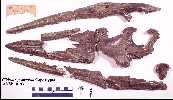 |
The skull of the type specimen of Clidastes propython Cope from Alabama. | ANSP 10193: Academy of Natural Sciences of Philadelphia, Philadelphia, PA. |
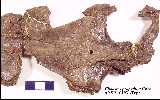 |
A close-up of the frontal and parietal of Clidastes propython Cope | ANSP 10193: Academy of Natural Sciences of Philadelphia, Philadelphia, PA. |
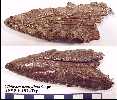 |
Ventral and dorsal views of the premaxilla and maxillas of Clidastes propython Cope. | ANSP 10193: Academy of Natural Sciences of Philadelphia, Philadelphia, PA. |
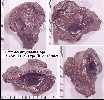 |
Four views of the right quadrate of Clidastes propython Cope. | ANSP 10193: Academy of Natural Sciences of Philadelphia, Philadelphia, PA. |
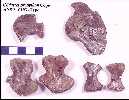 |
Front limb bones of Clidastes propython Cope. | ANSP 10193: Academy of Natural Sciences of Philadelphia, Philadelphia, PA. |
 |
Clidastes sp. - A left side view of the cast of a Clidastes liodontus skull from Kansas by Triebold Paleontology in the Tate Geological Museum, Casper College, Casper, Wyoming. Skull is about 2 feet in length. | Exhibited in the Tate Geological Museum, Casper, WY |
 |
A view of the same skull from a lower angle, showing the two rows of pterygoid teeth on roof of the mouth | Exhibited in the Tate Geological Museum, Casper, WY |
 |
Another side view. Clidastes skulls were proportionately longer and narrower than most other mosasaurs. | Exhibited in the Tate Geological Museum, Casper, WY |
 |
The head-on view of the same skull. Clidastes was the smallest of the three genera of mosasaurs found in the Western Interior Seaway. | Exhibited in the Tate Geological Museum, Casper, WY |
 |
Close-up of the left side of the skull, again showing the pterygoid teeth on the roof of the mouth. Note the hinge joint in the lower jaw, that allowed mosasaurs to flex their jaws and swallow their prey whole, much like a modern snake. | Exhibited in the Tate Geological Museum, Casper, WY |
 |
A left side view, further back on the skull. The bone that connects the lower jaw to the skull is called the quadrate. It also supports the tympanic membrane (eardrum) and is visible in modern lizards as the little round spot behind the eye. | Exhibited in the Tate Geological Museum, Casper, WY |
 |
Clidastes liodontus, as displayed in the old Sternberg Museum (center shelf ). Tylosaurus nepaeolicus (VP-2209) lower jaws at bottom right. | Sternberg Museum VP-2071 |
 |
Clidastes liodontus skull, Ventral and Dorsal views NEW 2/2000 Additional pictures here: Close up of the skull and the bones of the skull, labeled. | Sternberg Museum VP-2071 |
 |
Clidastes liodontus skull, dorsal view of frontal. This specimen is featured on the earliest Clidastes webpage. | Sternberg Museum |
 |
Clidastes liodontus skull, dorsal view of parietal and rear half of skull. This specimen is featured on the earliest Clidastes webpage. | Sternberg Museum |
 |
Clidastes liodontus skull, dorsal view of muzzle unit and left dentary. This specimen is featured on the earliest Clidastes webpage. | Sternberg Museum |
 |
Clidastes liodontus skull, ventral view of premaxilla and the anterior portions of the right/left maxillaries. This specimen is featured on the earliest Clidastes webpage. | Sternberg Museum |
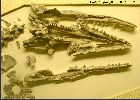 |
Clidastes "velox" - propython (KUVP
1022), ventral view of skull. This nearly complete specimen was collected by S.W.
Williston in 1891 along Bluff Creek in Logan County. Another specimen from a private collection is shown on the Clidastes propython page. |
The University of Kansas, Museum of Natural History |
 |
The left fore-paddle of Clidastes propython (KUVP 1022). | The University of Kansas, Museum of Natural History |
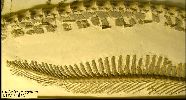 |
Dorsal (above) and caudal vertebrae of Clidastes propython (KUVP1022). Note the expansion of the dorsal processes near the end of thet tail. | The University of Kansas, Museum of Natural History |
 |
Clidastes tortor (= liodontus ?), ventral view of skull (KUVP 1000); collected by E.P West in 1889. | The University of Kansas, Museum of Natural History |
 |
A disarticulated Clidastes specimen from the Smoky Hill Chalk of South Dakota. (Unnumbered specimen) | The Museum of Geology at the South Dakota School of Mines and Technology |
 |
A overhead view of an small (14-16 inch) Clidastes skull from Alabama in preparation... The skull is extremely well preserved and appears to be almost 3-dimensional (very little crushing). | Museum Collection |
 |
A side view of the same skull. The specimen is from the Mooreville Chalk of Alabama and was found during the excavation for a construction project. | Museum Collection |